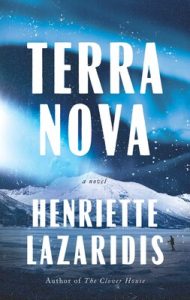The True to Life Inspirations for my Novel, Terra Nova
The True to Life Inspirations for my Novel, Terra Nova
By Henriette Lazaridis
 My favorite stories in childhood were adventure tales like Incredible Journey or Banner in the Sky. I always liked to imagine myself as an explorer, climbing and hiking in my small world of woods and snow and swamps. When, at age seven, I watched a documentary about Robert Falcon Scott’s race to the South Pole against Roald Amundsen, I became an ardent Scott fan. I don’t think I really realized that Scott had lost to Amundsen, but I did know that he had died on the way back. Most of all, I believed him to be supremely noble.
My favorite stories in childhood were adventure tales like Incredible Journey or Banner in the Sky. I always liked to imagine myself as an explorer, climbing and hiking in my small world of woods and snow and swamps. When, at age seven, I watched a documentary about Robert Falcon Scott’s race to the South Pole against Roald Amundsen, I became an ardent Scott fan. I don’t think I really realized that Scott had lost to Amundsen, but I did know that he had died on the way back. Most of all, I believed him to be supremely noble.
Scott became my hero. From then on, I imagined every outing into the snow, whether to ski or build a fort, as a Polar adventure. When we got a puppy months after I saw the documentary, I named him Scotty—because, like my hero, he liked the snow. (I’m sure that Robert Scott would not have used “like” in relation to the snow that contributed to his death, but this was what I thought when I was seven.) Adulthood has only strengthened my allegiance. When I’m out skiing or running or hiking in the cold, I keep casting my mind to Scott’s perseverance in the face of incomprehensible difficulties.
Over the years, what has fascinated me most about Scott isn’t the achievement but the very specific nature of his loss. After traveling hundreds of miles and suffering cold and hunger, Scott arrived at the Pole only to find the Norwegian flag already planted there. The very moment he achieved his goal—to reach the Pole—he saw that he had failed. What must that have felt like? What must it have been like to see the flag and know you were defeated? From his journals, we know how Scott described it officially. With classic Edwardian English diffidence, he wrote “It is a terrible disappointment, and I am very sorry for my loyal companions.” But what did he really think?
Scott’s story has been fictionalized at least once—in Beryl Bainbridge’s 1994 novel The Birthday Boys—and I didn’t want to try my hand at another telling. In any case, what interested me as a writer was the problem of an explorer who gives in to moral complications. I decided to tell this story with fictional characters of my own invention. My explorers Edward Heywoud and his photographer James Watts live in a sort of alternate history. It is 1910 and Scott has not yet departed on the actual Terra Nova expedition that gives my novel its name. Heywoud and Watts are racing a different, fictional, Norwegian. And when they reach the Pole? Well, let’s just say that Heywoud does not react to finding the Norwegian flag there with the same honor and dignity that Scott exhibited in real life.
But there was more behind Terra Nova than Antarctic explorers. With every explorer comes a photographer, and with photography comes the question of how an event is being captured and represented. For decades, I’d kept going back to Herbert Ponting’s images from Scott’s expeditions and Frank Hurley’s from Shackleton’s, awed by the beauty of the compositions that render this remote world in stark black and white. But as my idea for the novel was taking shape, I began to think about another photographer: the fashion photographer in Antonioni’s 1966 film Blow-Up, who discovers a murder when he’s in his darkroom enlarging images from a modeling shoot. I knew that photography in the Edwardian period was full of manipulations and tricks, so why not explore the way expedition photographs might reveal hidden truths or realities, or even distort reality, in the world of my explorers?
And finally, I had to think of the woman left behind by these two men. I wanted a character who would be a modern Penelope to their twin Odysseuses, but not unraveling her every day’s weaving, as Penelope does. Instead, my character of Viola Heywoud would keep making art, taking photographs, and using them to make a statement about female experience and power in the age of the suffrage movement. I named her Viola in homage to Twelfth Night.
An Edwardian Navy captain, a Shakespearean “trousers role,” and a character from a mod-era movie. Put them together and you get Terra Nova.
###
Henriette Lazaridis’s new novel, TERRA NOVA, will be published by Pegasus Books in December 2022. Her debut novel, The Clover House, was a Boston Globe bestseller and a Target Emerging Authors pick. Her work has been published in such outlets as Elle, Forge, Narrative Magazine, The New York Times, New England Review, The Millions, WBUR’s Cognoscenti and Pangyrus, and she is a recipient of a Massachusetts Cultural Council Artists Grant. Henriette earned degrees in English literature from Middlebury College, Oxford University, where she was a Rhodes Scholar, and the University of Pennsylvania. Having taught English at Harvard, she now teaches at GrubStreet in Boston. Visit her website at https://www.
TERRA NOVA
 A haunting story of love, art, and betrayal, set against the heart-pounding backdrop of Antarctic exploration—from the Boston Globe-bestselling author of The Clover House.
A haunting story of love, art, and betrayal, set against the heart-pounding backdrop of Antarctic exploration—from the Boston Globe-bestselling author of The Clover House.
The year is 1910, and two Antarctic explorers, Watts and Heywoud, are racing to the South Pole. Back in London, Viola, a photo-journalist, harbors love for them both. In Terra Nova, Henriette Lazaridis seamlessly ushers the reader back and forth between the austere, forbidding, yet intoxicating polar landscape of Antarctica to the bustle of early twentieth century London.
Though anxious for both men, Viola has little time to pine. She is photographing hunger strikers in the suffrage movement, capturing the female nude in challenging and politically powerful ways. As she comes into her own as an artist, she’s eager for recognition and to fulfill her ambitions. And then the men return, eager to share news of their triumph.
But in her darkroom, Viola discovers a lie. Watts and Heywoud have doctored their photos of the Pole to fake their success. Viola must now decide whether to betray her husband and her lover, or keep their secret and use their fame to help her pursue her artistic ambitions.
Rich and moving, Terra Nova is a novel that challenges us to consider how love and lies, adventure and art, can intersect.
Category: How To and Tips

























